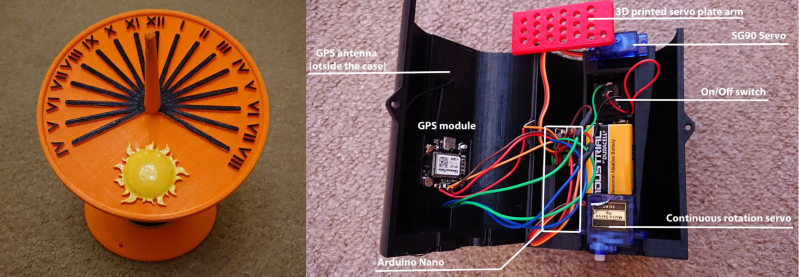Sundials, one of humanity’s oldest ways of telling time, are typically permanent installations. The very good reason for this is that telling time by the sun with any degree of accuracy requires two-dimensional calibration — once for cardinal direction, and the other for local latitude.
[poblocki1982] is an amateur astronomer and semi-professional sundial enthusiast who took the time to make a self-calibrating equatorial ‘dial that can be used anywhere the sun shines. All this solar beauty needs is a level surface and a few seconds to find its bearings.
Switch it on, set it down, and the sundial spins around on a continuous-rotation servo until the HMC5883L compass module finds the north-south orientation. Then the GPS module determines the latitude, and a 180° servo pans the plate until it finds the ideal position. Everything is controlled with an Arduino Nano and runs on a 9V battery, although we’d love to see it run on solar power someday. Or would that be flying too close to the sun? Check out how fast this thing calibrates itself in the short demo after the break.
Not quite portable enough for you? Here’s a reverse sundial you wear on your wrist.
















If you have GPS, why not just use that and a timezones table to find the current time very exactly?
It’s unique, it’s non-obvious, a roomful of geniuses couldn’t have come up with it in a month, it climbed right out of the box and crawled underneath it. Imagine if we could apply this kind of thinking to the major problems of the world today. I know, maybe Africa wouldn’t be short of drinking water if they just bought vodka and boiled off the alcohol !!
I think the reason author created this thing wasn’t he couldn’t find a way to find current time.
Wait … if it’s got a GPS, then it already knows the exact time! :D
Maybe you could display the time during dark hours via the GPS signal clock.
Install an LED casting a shadow for the dark hours .
Bingo! Give that man a cigar.
Ahh, the indoor sundial I always needed
I’d like to be the first to point out the irony of using gps, probably the most accurate clock around, to set a sundial.
dammit, I would’ve been the first if I didnt spend so much time correcting typos!
Not everything needs to be practical, after all
No, everything does need to be. Screw all this artsy-fartsy stuff.
I’d think this was more whimsy than artsy… :-)
Nonsense! Neither artsy-fartsy nor whimsy! It was a flight of fancy!
“It was a flight of fancy!” – exactly, which makes it a hack, and thus perfect for this site
Next level: also use the longitude information and correct for magnetic declination.
Then, use the calendar information to do the analemma correction too.
And, heck, since you have power and servos, you may as well put a sun-simulating LED on it to run it at night too.
Can this been done with maths rather than a GPS? As far as it is required for calculating the solar time the length and shape of the curve the sun path traces for a given period of time may be enough to determine longitude and time of year which can then be used to calculate time. You can see what I mean if you play with the sliders here: http://andrewmarsh.com/apps/releases/sunpath2d.html
It could have been done with a watch. Look at the time…now look at the sundial. Notice that the sundial is off. Move sundial. Check back in 6 months.
“…although we’d love to see it run on solar power someday.” All sundials use “solar power” in that they can’t operate without sunlight, and this one is no different, it just uses a 9V for setup.
And you though using an Arduino instead of a 555 was overkill :-P
Really nice project, well done!
Forget the GPS time-seekers. This is utterly charming.
However, only of much use if the sundial is regularly moved and only really shows its true utility when it is moved great distances. Most of my projects just sit on the shelf.
https://www.mojoptix.com/2015/10/25/mojoptix-001-digital-sundial/
Reminds me of Crocodile Dundee.
He can also estimate the time from just looking at the sun with enough accuracy to impress ladies.
About sundials, I retriveved this one on the wayback machine
https://web.archive.org/web/20101007163209/http://www.5volt.eu/archives/72
https://web.archive.org/web/20190121092649/https://www.flickr.com/photos/5volt/3260213536/
Add another servo to move an led to cast a shadow in the dark hours. Or all the time for an indoor sundial.